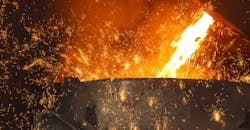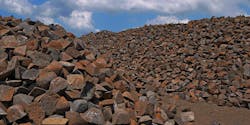The U.S. government imposed import tariffs on a wide range of products and materials, one effect of which for foundries melting ferrous alloys is rising pig iron costs.
Pig iron is refined iron ore produced in blast furnaces, an intermediate form of iron with high carbon content that’s useful as raw material to ferrous foundries and steelmakers. The United States imported an estimated 3.8 million metric tons of pig iron in 2024, mostly from Brazil, India, South Africa, and Canada. The estimated total value of the imported material is $2.1 billion – and that figure represents the costs before the application of 50% tariffs on imported materials.
For foundries relying on pig iron to optimize the metallurgical quality of the ferrous alloys they pour, this problem can and must be addressed to preserve the businesses’ profitability. And the solution is at hand.
Pig iron is added to enhance the precipitation of graphite during solidification. For years and years, salesmen have touted many properties that pig iron provides to molten iron; unfortunately, but most of those are false attributes.
However, there is one true benefit to adding pig iron for ferrous alloys -- pig iron promotes carbon precipitation as graphite during solidification.
Graphite formation tendencies during solidification have long been investigated by metallurgists. Numerous nucleation and growth theories have surfaced regarding graphite formation, leading to many misleading and generally confusing claims and advice. There has not been a consensus of opinion.
Free-oxygen atoms, present in all conventionally melted iron, strongly retard carbon atoms’ precipitation as graphite. They are the "bad actor" in iron solidification. Free-oxygen atoms’ effect has eluded technologists, and few of them understand its fateful interaction.
Free oxygen favors solid solution forms of carbon, promoting elevated levels of carbide formation tendencies upon solidification. Inoculation and other “tricks" have been used to produce graphite precipitation.
Effects of free oxygen
With the advent of iron deoxidation, the adverse effects of free-oxygen contamination of molten iron has been eliminated. Deoxidation removes free-oxygen atoms from molten iron, which eliminates their harmful effects. In deoxidized iron, carbon atoms are free to precipitate as graphite, which is nature's desired equilibrium.
Metal treatment with Mastermelt’s DeOX additive blend will eliminate free-oxygen atom contamination. Free-oxygen atoms and their source are no longer present in the molten metal. The new metal grade produced is now available, free of instant re-contamination.
To detail further, pig iron creates nucleation sites that favor graphite formation, but eliminating free-oxygen atoms from the molten iron matrix eliminates the need for those extra nucleation sites. Deoxidized iron readily forms graphite flakes or nodules during solidification, thereby eliminating the need for the extra nucleation sites pig iron would provide.
Metallurgical superiority
Mastermelt deoxidized iron has demonstrated its metallurgical superiority in graphite formation. Deoxidized molten iron, held for 50-plus days in a 35-ton horizontal drum furnace, produced a 2/32 chill depth in a one-quarter-inch chill wedge, as-cast , without inoculation – an unheard-of and never-duplicated achievement in past iron melting. Thirty-five tons of this "held" iron was later cast into tough intricate castings without a single scrap casting.
Mastermelt deoxidized iron also demonstrated its superior graphite formation tendencies when 20% pig iron was replaced with auto-cast scrap, without increasing the shrinkage tendency of the solidifying iron. The foundry found no change in solidification characteristics with the "no-pig" iron, maintaining its outstanding 90% casting yield.
Pig iron usage can now be reduced or eliminated without any concern or risk to iron quality.
Carbide formation in ductile iron has favored pig iron additions to the electric furnace melt. Residual element levels have been carefully controlled. Now, with deoxidized iron and the accompanying change in the carbon atoms' metallurgical behavior, pig iron no longer provides any effect.
Carbide-free production quantities of ductile iron (400 tons) have been produced containing 0.30% Cr. Chrome can be used to produce pearlitic DI , completely eliminating the use of copper.
Oxygen’s source
The role of oxygen atoms in molten iron remained elusive due to its inability to accurately determine its presence and concentration. Even the source of the oxygen atom in molten iron remained unknown until Mastermelt engineers revealed how it enters molten iron. There is only one critical supply chain for the oxygen atom in molten iron. Molten iron readily reacts with the atmosphere to form iron oxide, which is the key to the oxygen atom's existence: FeO = Fe + O.
Steelmakers face the same issues as iron foundries, but steelmaking is done at higher temperatures than iron melting, producing iron oxide more readily. The steel industry attempts to isolate liquid steel from atmospheric contact, but they recognize that it cannot be done completely. So, critical steel grades are treated with aluminum to tie-up the free-oxygen atoms. Iron cannot tolerate those aluminum levels, so the ironmakers have tolerated oxygen contamination since the beginning of the Iron Age.
Mastermelt's DeOX Metal Treatment reduces free oxygen to the inert level, and an almost new grade of iron is created. Tensile strength increases due to improved cleanliness in both cast iron and ductile iron. The previously suspended, nano-sized oxides acted as crack initiation sites. Elongation in ductile iron increases, sometimes having achieved 25% as-cast.
The fact that deoxidation controls carbon-atom-graphite precipitation means that control of the DeOX addition rate indirectly controls the casting hardness range.
Iron deoxidation changes the aim chemistry levels for both cast iron and ductile iron grades. Conventionally melted Class 30 CI nears Class 40 CI when deoxidized, with no chemistry change. The need for expensive alloys such as molybdenum, tin, copper, nickel, and manganese is eliminated.
Carbon levels, which determine CI strength, can be increased to favor castability and casting yield, without jeopardizing strength.
Deoxidized ductile iron typically tests at 95,000 psi tensile and 17% elongation, as-cast. In foundry operations, 130,00 psi and 9% elongation DI has been produced.
Deoxidation and the judicious use of the DeOX opens new avenues for establishing metallurgical specifications. Much change lies ahead.
About the Author
Ron Beyerstedt
Ron Beyerstedt is the president of Mastermelt LLC. Contact him at [email protected]

